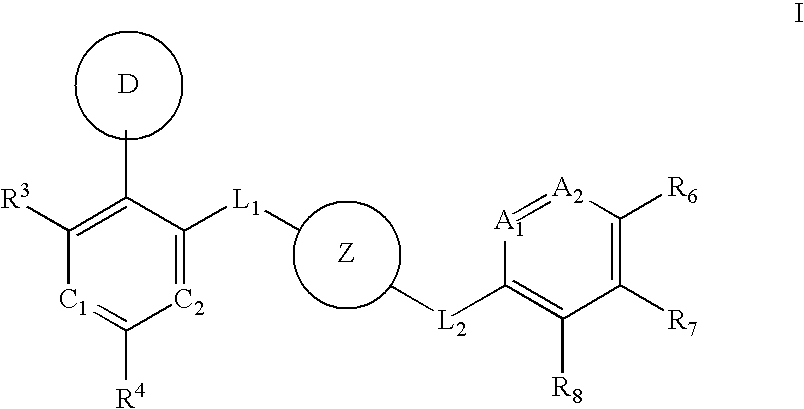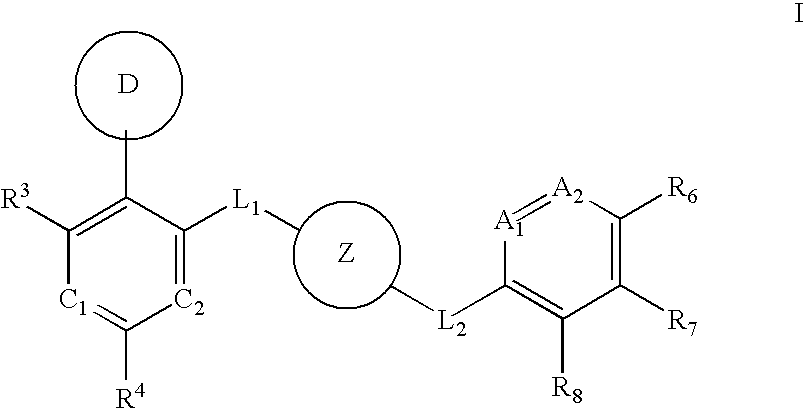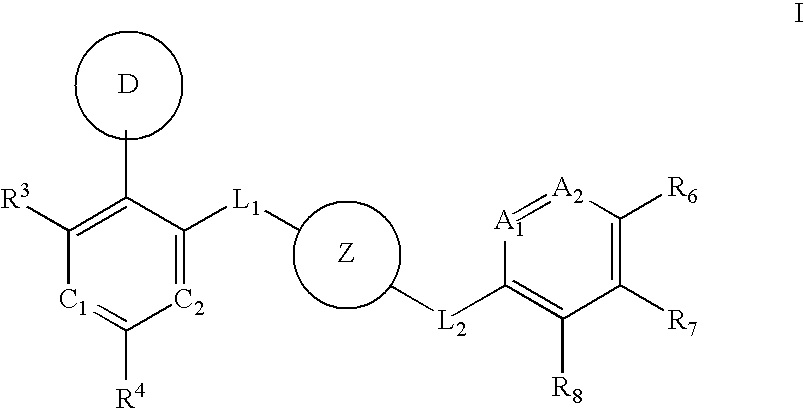Aurora kinase modulators and method of use
a kinase and Aurora technology, applied in the field of pharmaceutical agents, can solve the problems of affecting mankind and a major cause of death worldwide, few offer any considerable degree of success, and loss of normal cell proliferation regulation,
- Summary
- Abstract
- Description
- Claims
- Application Information
AI Technical Summary
Benefits of technology
Problems solved by technology
Method used
Image
Examples
example 1
[0289]
Synthesis of 2-chloro-4-(2-chloro-pyridin-3-yl)-[1,3,5]triazine
Step 1: Preparation of 2-chloro-nicotinamidine
[0290]2-Chloro-3-cyanopyridine (5.0 g, 36 mmol) was dissolved in dry EtOH (100 mL) at 0° C. HCl was bubbled through the mixture for 3 h and the mixture was sealed and refrigerated (about 8° C.) overnight. After concentration, the residue was stirred with ammonium acetate (5.5 g) in 100 mL IpOH. After 12 h, the pH was adjusted to 9 (from 4) using concentrated NH4OH solution, and stirring continued two more days. The mixture was concentrated and purified by flash chromatography (10:1:0.1 CH2Cl2 / MeOH / NH4OH). Trituration in hot tBuOMe / IpOH removed some residual amide side-product to provide the product as a white solid.
Step 2: Preparation of amino-(2-chloro-pyridin-3-yl)-methylcyanamide
[0291]2-Chloro-nicotinamidine was suspended in 10 mL IpOH with 500 mg solid cyanamide and the stirring solids were dissolved by addition of 5% aqueous NaHCO3 (30 mL). After two days stirring,...
example 2
[0293]
Synthesis of [4-(2-Chloro-pyridin-3-yl)-[1,3,5]triazin-2-yl]-methyl-amine
[0294]To 2-chloro-4-(2-chloro-pyridin-3-yl)-[1,3,5]triazine (10.0 g, 44.0 mmol) in 55 ml of methylene chloride was added methylamine (45 ml, 88.0 mmol) as a 2.0 M solution in THF at 0° C. After stirring at room temperature for 18 h, the mixture was diluted with acetone and filtered through a plug of silica gel and concentrated to yield the desired product. MS m / z=222 [M+H]+. Calc'd for C9H8ClN5: 221.65.
example 3
[0295]
Synthesis of 4-(2-Chloro-pyridin-3-yl)-pyrimidine
Step 1. Preparation of 1-(2-Chloro-pyridin-3-yl)-3-dimethylamino-propenone
[0296]1-(2-Chloro-pyridin-3-yl)-ethanone (21.7 g, 139 mmol) in 46 mL N,N-dimethylformamide, dimethyl acetal (42 g, 350 mmol) was heated under a drying tube at 85° C. for 1.5 h and concentrated. The residue was purified by suction filtration chromatography (using 150 g silica in a Buchner funnel, with rapid collection of fractions eluting with 10:1 and then 5:1 CH2Cl2 / IpOH) to provide yellow solid product. MS m / z=211 [M+H]+. Calc'd for C10H11ClN2O: 210.66.
Step 2. Preparation of 4-(2-Chloro-pyridin-3-yl)-pyrimidine
[0297]Sodium methoxide was generated over a period of 1.5 h by the intermittent addition of small chunks of sodium metal (8.3 g total, 360 mmol) to 400 mL dry methanol under N2 at room temperature, using a bath of 500 mL IpOH at room temperature as a heat sink. Formamidine acetate (42.7 g, 410 mmol) was added, followed ten minutes later by the enam...
PUM
 Login to View More
Login to View More Abstract
Description
Claims
Application Information
 Login to View More
Login to View More - R&D
- Intellectual Property
- Life Sciences
- Materials
- Tech Scout
- Unparalleled Data Quality
- Higher Quality Content
- 60% Fewer Hallucinations
Browse by: Latest US Patents, China's latest patents, Technical Efficacy Thesaurus, Application Domain, Technology Topic, Popular Technical Reports.
© 2025 PatSnap. All rights reserved.Legal|Privacy policy|Modern Slavery Act Transparency Statement|Sitemap|About US| Contact US: help@patsnap.com



